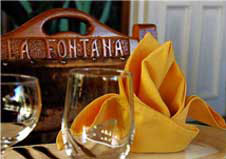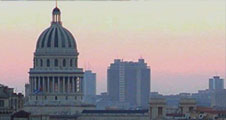Cuban Popular Music in the 20th Century (2nd part)
By: Senén Suárez Hernández | Source: CUBARTE | 11 de October 2009
Among the most outstanding musical currents are the trios, the duets and those trobadours with an innate vocation for the Cuban music in general.
In this sense, we could talk about one of the best interpreters of our Music, Miguel Matamoros, who worked as a private household car driver-chauffeur-; see how Nature is, how ineffable, unpredictable and whimsical she is... “tell me if you´re as freer as the wind...”
Arsenio Rodriguez, blind since he was seven; “after twenty desillusions, what does one more matters...”
Tata Guines, the best percussionist of the world at playing conga drums, the tumbadora, who can refute that, after an artist is born, life is in charge of improving him?
We have arrived to the prodigious, miserable and fruitful decade of the nineteen-forties, where the new musical genders arouse, like the Son, Danzon, Danzonete and other musical forms.
The main motif was, without a doubt, the radio, which was forced to promote the different groups that were created in our capital, as we explained before.
We can´t forget that, up to that moment, there was only one disc recording company in Havana, the RCA Victor dealership . This company sold the discs at very high prices, since it didn´t have enough resources and, besides, it was not so easy to record in Havana and produce the discs in New York. That took months, and this made that the discs that arrived to our country were out of fashion by that time.
Each musical group in Havana had a space in the radio. Though we did not have money to pay for it, the promotion was guaranteed. It is possible that some radio stations paid some low wages to the artists or their tickets to perform in other places.
Which were some of the groups who benefitted from this during this decade?
We could mention, for example, Arsenio Rodriguez and his “All Stars”; the “Casino” ensemble, the champions of the rhythm; Antonio Arcano and “His Wonder”s; the Orchestra “Casino de la Playa” with Miguelito Valdes; the “Sonora Matanzera” with Bienvenido Granda and others; “Antonio Maria Romeu” with his solo singer, Barbarito Diez; the “Conjunto Colonial” with Nelo Sosa; “Melodias del 40” -Nineteen-Forties´ Melodies- with Rosquille and Rene Alvarez; the “Servando Diaz” trio; the “Hermanos Torres” trio; the “Hermanas Lago”; the “Hermanas Marti”; the Justa Garcia trio, with the provitional musicians Maria Teresa Vera, Dominica Bergues, and the guitar players Lorenzo Hierrezuelo and Nene Allue.
We left for the end the “Matamoros” trio (image), since, by mid of the nineteen-forties´ decade, Miguel added other artists to the group, becoming it an ensemble to perform in Mexico. He introduced, among others, a vocalist called Maximiliano More -who, thanks to Ciro Rodriguez, became Benny More-, as well as Ramon Dorca, etc.
Long Live Cuban Son!, a friend of mine used to say, but.. why? -I asked him and he answered me: “Because the Son leads other musical genders, like the changui, the sucu-suco... And, what about the mambo?
The mambo is a hybrid, that takes a little from all. It was created from the charanga, and takes elements from the son, the rumba and even from jazz; but, you can´t be sure that that Cuban, from Matanzas province, Damaso Perez Prado, managed so well so that mambo had the taste of the Cuban music.
Damaso left his province too young, being a five-year old kid, and arrived in Havana in 1942, leaving for Mexico in 1947.
Prado was born in Matanzas on December 11, 1917 and died in Mexico, F.D. On September 14, 1989. We should say that he had a successful career in Mexico.
I asked my friend about the bachata, which was considered a foreign rhythm, and he explained to me that this musical form and the way of singing the bachata was reproduced by Pablo Quevedo in the nineteen-thirties and by Orlando Vallejo in the nineteen-fifties... and, stop there!, he warned me...
What about rumba? -I asked him-, and he told me, “well, this rhythm was brought to Cuba by the African Black Slaves and, it is possible, that by the Spaniards too; the Cubans made some contributions to it.
Rumba is a mixture of three musical forms: the Yambu, the Guaguanco and the Columbia. The musical instruments used for it are the drums, the tumba, the llamador and the quinto, to which add the voices and small percussion instruments.
As an interesting data, he told me that, in Sabanilla del Encomendador, a little town located in Matanzas, today “Juan Gualberto Gomez”, was born, on October 5, 1885, the son of Fuciana Oviedo and unknown father, Jose Rosario Oviedo, a.k.a. “Malanga”. From him, the famous Isaac Oviedo commented: “I´ve seen Chenche and Mulence dancing the rumba, but what Malanga did was incomparable.”
Among some of his eccentricities were dancing with a glass of rum on his head, without spilling a single drop. He was a sugar cane cutter . His colleague, Arsenio Rodriguez paid tribute to him, by creating a Guaguanco titled: “Malanga died”. Some commented he was poisoned in Camaguey.
I hear a voice that tells me:
Are ni lleo
I hear a voice that tells me
Malanga died.
Union de Reyes is mourning
His best timbero
Who was watering flowers
From Matanzas to Moron
Going back to our subject, the rumba, we can say that Jesus Goris, owner of “Puchito”´s Disc Shop, recorded some pieces of an unknown musical group from Matanzas, named “Guaguanco Matancero”, that was only accompanied by drum players.
Within this group there were two vocalists, among others, named Saldiguera and Viruliya. The group had, in its repertoire, a guaguanco that made allusion to a Comic strip that appeared on Saturday´s issues of “El Mundo” newspaper, with several of its characters like “Anita la huerfanita” -Anita, the little orphan-, Jorge el Piloto -George, the Pilot-, and others.
This musical piece became very popular, so the rumba ensemble changed its name and, from 1956 on, Goris called it “Munequitos de Matanzas”. From that time up to the present, this musical ensemble has been an excellent group and kept a very good quality.
During the 1930-40 decade, which we´re reflecting on the permanent value of Cuban music, we may say that the 90% of this music remained in the programs of all the radio stations existing in Cuba, since those industries that advertised on the radio, demanded quality, and the owners of the radio stations found this in the musical groups and radio soap-operas. Sometimes, the musicians and musical groups created their own ads..
The bolero was born in the prodigious Cuban Eastern region and, following the history, its first steps came from the hands of the guitarist and composer Jose Pepe Sanchez, without disregarding other big talents of the Cuban trova movement.
These works made for pleasure (without rhythm) were stick, in most of the cases, to the bolero form in the case of the groups that had a popular reputation. We could say that all Cuban popular music is interconnected.
And talking about the nineteen-forties, we should highlight the importance of the start up of the “Panart” Disc Company, located in Campanario and San Miguel, in the City of Havana.
Another important event was the arrival in Havana of Orlando Guerra (a.k.a. Cascarita), who was a boom for our musical world, with his eccentric way of performing and recording his discs.
Re-taking the issue of the recordings and its consequences, it is fair to say that the unknown groups without having any possibility to record their discs, were called by the already mentioned “Panart” Disc Company, which created a strong competition between the RCA Victor and Panart itself, among other things, because it was easy for the Cuban Disc Company to print the discs very fast here in Cuba at its own plant , and also because it put in the hands of the interested, in a fast way and very cheap, those update and popular musical works.
The musical albums of the “Panart” records company presented popular artists and groups among whom were: Fernando Albuerne, Chico O´Farrill, All Star Cuban Band, Orquesta Julio Gutiérrez, Rosita Fornes, Olga & Tony, Cheo Marquetti, Garrido & Piñeiro, Orquesta Riverside with Tito Gómez, Luis Pérez Mesa, “Servando Díaz” trio, Neno González, “Senén Suárez” ensemble, “Almendra” orchestra, “Casino” ensemble, “América” orchestra, Joseíto Fernández, “Sonora Matancera” with Bienvenido Granda & Daniel Santos, besides a long list of groups and soloists which would be this work of reminiscences about our musical heritage unfinished.
All of a sudden, at that time, the “Ramon and Ernesto Sabat”´s brothers, as well as our musicians and soloists, had, with other composers, a rather loose situation, only that along the time, we realized that they had mutual needs.
Some of the works that were part of the Cuban Popular Music repertoire during the first half of the 20th Century were:
- “El Manisero” -The Peanuts´ Vendor;
- Pregon, by Moises Simons;
- "Almendra Danzon”, by Abelardito Valdes;
- “Tres Lindas Cubanas”, a Son by Guillermo Castillo;
- “Ola Marina, a guaracha by Virgilio Gonzalez;
- “La Última Noche”, a bolero by Boby Collazo;
- “A toda Cuba le gusta la Guaracha”; by Remberto Bequer;
- “La Culebra Afro”, by Obdulio Morales;
- “En el Tiempo de la Colonia Afro”, by Mario Recio;
- “El Bodeguero”, a Cha Cha Cha, by Richard Egües;
- “Rico Vacilón”, a Cha Cha Cha by Rosendo Ruiz;
- “Al Vaivén de mi Carreta” and “Maria Cristina” by Ñico Saquito
- “Yerbero Moderno”, a guaracha by Néstor Mili;
- “Mata Siguaraya”, afro, by Lino Frías;
- Buena Vista Social Club, danzón, by Orestes López;
- “A mi qué”, a guaracha, by Jesús Guerra;
- “A mi manera”, a bolero by Marcelino Guerra;
- “Izora”, danzón, by Coralia Lópes;
- “Quizás Quizás”; “Quizás”, a bolero by Osvaldo Farrés;
- “Buscando la melodía”, a son by Julio Blanco Leonard;
- “Amorosa Guajira”, a guajira by González Allüé;
- “Una Dos y Tres”, a conga, by Rafael Ortiz;
- “Panamá”, a conga, by Ernesto Lecuona;
- “Las Muchachas del Cha Cha Cha”, by Evelio Landa;
- “Cómo está Miguel”, a son by Felipe Neri Cabrera;
- “Rompiendo la Rutina” a danzonete, by Aniceto Díaz;
- “Como fue”, a bolero by Ernesto Duarte;
- “Chacumbele” a son by Alejandro Mustelier;
- “Domitila, dónde vas”, by Ricardo Díaz;
- “Que te hace pensar”, by Ricardo Pérez;
- “Me lo dijo Adela”, a Cha Cha Cha by Otilio Portal;
- “El Cuento del Sapo”, a guaracha, by Felix Cárdenas; - “El Golpe de Bibijagua” a son by Julio Cueva;
- “Yo sí como Candela”, a son, by Félix Chapottín;
- “El Quibombo” , a guaguancó by Luis Griñán;
- “Que se Fuñan”, a guaguancó by Luis Martínez Griñán;
- “El Amor de mi Bohío”, a guajira by Julio Brito;
- “Si te Contara”, a bolero;
- “El Niche”, a son by Felix Reina;
- “Algo de ti”, a bolero by Juan Pablo Miranda;
- “Los Aretes de la Luna”, a bolero by José Dolores Quiñónez;
- “Quiero hablar contigo”, a bolero by Carlos Puebla;
- “La Sopa en botella”, a guaracha by Senén Suárez;
- “La Cazuelita”, by Gelasio Deliz;
- “Estoy como nunca”, a guaracha by Enrique Raimat González;
- “Deuda” a bolero by Luis Marquetti;
- “Timba Timbero”, a guaracha by Alfonso Salina;
- “Oriente, cuna florida”, a bolero by Emiliano Ponciano;
- “Lágrimas negras”, a bolero;
- “Son de la Loma”, by Miguel Matamoros.
And, to end up with this section, we may say that “Music is the Peoples´ Souls”, like our National Apostle, Jose Marti, said once, and that it will keep on being an important part of our Musical Heritage.
(To be continued...)
Acknowledgements
Manuel Villar Fernández, Music Researcher
José Galiño, Music Researcher and Historian
BAs. Belinda de la Caridad Suárez Pesi
BAs. Roberto Payeras García
Translation: Roxana Marquez Herrera (Cubarte)























